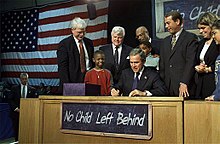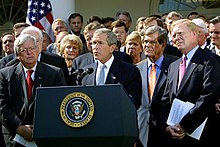Type a search term to find related articles by LIMS subject matter experts gathered from the most trusted and dynamic collaboration tools in the laboratory informatics industry.
| 107th United States Congress | |
|---|---|
106th ← → 108th | |
 United States Capitol (2002) | |
January 3, 2001 – January 3, 2003 | |
| Members | 100 senators 435 representatives 5 non-voting delegates |
| Senate majority | Democratic (with tie-breaking VP) (until January 20, 2001) Republican (with tie-breaking VP) (Jan 20, 2001 – Jun 6, 2001) Democratic (through caucus) (from June 6, 2001) |
| Senate President | Al Gore (D)[a] (until January 20, 2001) Dick Cheney (R) (from January 20, 2001) |
| House majority | Republican |
| House Speaker | Dennis Hastert (R) |
| Sessions | |
| 1st: January 3, 2001 – December 20, 2001 2nd: January 23, 2002 – November 22, 2002 | |




The 107th United States Congress was a meeting of the legislative branch of the United States federal government, composed of the United States Senate and the United States House of Representatives. It met in Washington, D.C., from January 3, 2001, to January 3, 2003, during the final weeks of the Clinton presidency and the first two years of the George W. Bush presidency. The apportionment of seats in this House of Representatives was based on the 1990 United States census.
The House of Representatives had a Republican majority throughout the session, while the Senate was tied 50–50 for only the second time in history resulting in numerous changes in the majority. Vice President Al Gore gave Democrats a majority for 17 days, then a Republican majority after Dick Cheney became Vice President on January 20, 2001. Senator Jim Jeffords (R-VT) became an independent who caucused with the Democrats on June 6, 2001, giving the party a 51–49 majority for the rest of the Congress.
When Bush was sworn in as president on January 20, the Republicans held a federal trifecta for the first time since the 83rd Congress in 1955.
A rare even split in the United States Senate, the defection of a Senator, and the inauguration of a new Vice President, led to three changes in majorities.
| Party (Shading indicates party control)
|
Total | ||||||
|---|---|---|---|---|---|---|---|
| Democratic | Independent | Independence | Republican | Vacant | |||
| End of previous Congress |
46 | 0 | 0 | 54 | 100 | 0 | |
| Begin[c] | 50 | 0 | 0 | 50 | 100 | 0 | |
| January 20, 2001[d] | 50 | 50 | |||||
| June 6, 2001[e] | 50 | 1 | 49 | ||||
| October 25, 2002[f] | 49 | 99 | 1 | ||||
| November 4, 2002[f] | 1 | 100 | 0 | ||||
| November 23, 2002[g] | 48 | 1 | 50 | ||||
| November 30, 2002[h] | 49 | 99 | 1 | ||||
| December 2, 2002[h] | 50 | 100 | 0 | ||||
| Final voting share | 49% | 1% | 50% | ||||
| Beginning of the next Congress |
48 | 1 | 0 | 51 | 100 | 0 | |
| Party (Shading indicates majority caucus)
|
Total | |||||
|---|---|---|---|---|---|---|
| Democratic | Independent | Republican | Vacant | |||
| caucused with Democrats |
caucused with Republicans | |||||
| End of previous Congress | 208 | 1 | 1 | 222 | 432 | 3 |
| Begin | 211 | 1 | 1 | 221 | 434 | 1 |
| January 31, 2001 | 220 | 433 | 2 | |||
| March 30, 2001 | 210 | 432 | 3 | |||
| May 15, 2001 | 221 | 433 | 2 | |||
| May 28, 2001 | 209 | 432 | 3 | |||
| June 5, 2001 | 210 | 433 | 2 | |||
| June 19, 2001 | 222 | 434 | 1 | |||
| August 5, 2001 | 221 | 433 | 2 | |||
| August 16, 2001 | 220 | 432 | 3 | |||
| September 6, 2001 | 219 | 431 | 4 | |||
| October 16, 2001 | 211 | 220 | 433 | 2 | ||
| November 20, 2001 | 221 | 434 | 1 | |||
| December 18, 2001 | 222 | 435 | 0 | |||
| July 24, 2002 | 210 | 434 | 1 | |||
| August 1, 2002 | 0 | 223 | ||||
| September 9, 2002 | 209 | 433 | 2 | |||
| September 28, 2002 | 208 | 432 | 3 | |||
| November 30, 2002 | 209 | 433 | 2 | |||
| Final voting share | 48.5% | 51.5% | ||||
| Beginning of the next Congress | 205 | 1 | 0 | 229 | 435 | 0 |
Senators are listed by their class. In this Congress, Class 2 meant their term ended with this Congress, facing re-election in 2002; Class 3 meant their term began in the previous Congress, facing re-election in 2004; and Class 1 meant their term began in this Congress, facing re-election in 2006.
|
|
 2 Democrats 1 Democrat and 1 Republican 2 Republicans Senate majority leadership (Majority until January 20 and minority until June 6, 2001; majority thereafter) Senate minority leadership (Minority until January 20 and majority until June 6, 2001; minority thereafter)
|
Congressional district numbers are linked to articles describing the district itself.
| State (class) |
Vacated by | Reason for change | Successor | Date of successor's formal installation[j] |
|---|---|---|---|---|
| Vermont (1) | Jim Jeffords (R) | Incumbent changed party and joined the Democratic caucus. | Jim Jeffords (I) | June 6, 2001 |
| Minnesota (2) | Paul Wellstone (D) | Incumbent died October 25, 2002. Successor appointed to serve the remaining two months of the term. |
Dean Barkley (IMN) | November 4, 2002 |
| Missouri (1) | Jean Carnahan (D) | Interim appointee lost election. Successor elected November 5, 2002. |
Jim Talent (R) | November 23, 2002 |
| Texas (2) | Phil Gramm (R) | Incumbent resigned November 30, 2002, to give successor seniority advantages. Successor appointed on December 2, 2002, having already been elected to the next term.[4][5] |
John Cornyn (R) | December 2, 2002 |
| Alaska (3) | Frank Murkowski (R) | Incumbent resigned December 2, 2002, to become Governor of Alaska. Successor appointed to remainder of the term ending January 3, 2005. |
Lisa Murkowski (R) | December 20, 2002 |
| District | Vacated by | Reason for change | Successor | Date of successor's formal installation[j] |
|---|---|---|---|---|
| California 32nd | Vacant | Incumbent Julian Dixon (D) had died December 8, 2000, before the beginning of this Congress. A special election was held June 5, 2001. |
Diane Watson (D) | June 5, 2001 |
| Pennsylvania 9th | Bud Shuster (R) | Incumbent resigned, effective January 31, 2001. A special election was held May 15, 2001. |
Bill Shuster (R) | May 15, 2001 |
| Virginia 4th | Norman Sisisky (D) | Incumbent died March 30, 2001. A special election was held June 19, 2001. |
Randy Forbes (R) | June 19, 2001 |
| Massachusetts 9th | Joe Moakley (D) | Incumbent died May 28, 2001. A special election was held October 16, 2001. |
Stephen Lynch (D) | October 16, 2001 |
| Arkansas 3rd | Asa Hutchinson (R) | Incumbent resigned August 5, 2001, to head the Drug Enforcement Administration. A special election was held November 20, 2001. |
John Boozman (R) | November 20, 2001 |
| South Carolina 2nd | Floyd Spence (R) | Incumbent died August 16, 2001. A special election was held December 18, 2001. |
Joe Wilson (R) | December 18, 2001 |
| Florida 1st | Joe Scarborough (R) | Incumbent resigned, effective September 6, 2001. A special election was held October 16, 2001. |
Jeff Miller (R) | October 16, 2001 |
| Oklahoma 1st | Steve Largent (R) | Incumbent resigned, effective February 15, 2002, to concentrate on his campaign for governor. A special election was held January 8, 2002. |
John Sullivan (R) | February 15, 2002 |
| Ohio 17th | Jim Traficant (D) | Incumbent expelled July 24, 2002, for criminal conviction of 10 counts of bribery, racketeering, and tax evasion. | Vacant | Not filled for remainder of Congress |
| Virginia 5th | Virgil Goode (I) | Incumbent changed party. | Virgil Goode (R) | August 1, 2002 |
| Ohio 3rd | Tony P. Hall (D) | Incumbent resigned September 9, 2002, after he was appointed to be the U.S. Ambassador to the United Nations Food and Agriculture Organization. | Vacant | Not filled for remainder of Congress |
| Hawaii 2nd | Patsy Mink (D) | Incumbent died September 28, 2002, but was elected posthumously on November 5, 2002. | Ed Case (D) | November 30, 2002 |
Lists of committees and their party leaders for members of the House and Senate committees can be found through the Official Congressional Directory at the bottom of this article. The directory after the pages of terms of service lists committees of the Senate, House (Standing with Subcommittees, Select and Special) and Joint and, after that, House/Senate committee assignments. On the committees section of the House and Senate in the Official Congressional Directory, the committee's members on the first row on the left side shows the chairman of the committee and on the right side shows the ranking member of the committee.
![]() This article incorporates public domain material from the Biographical Directory of the United States Congress
This article incorporates public domain material from the Biographical Directory of the United States Congress